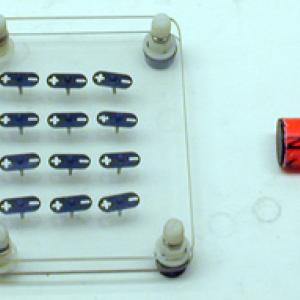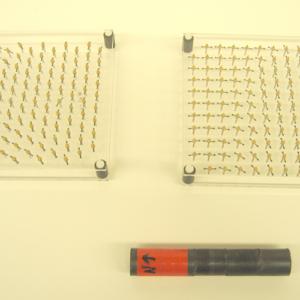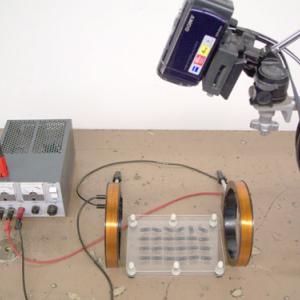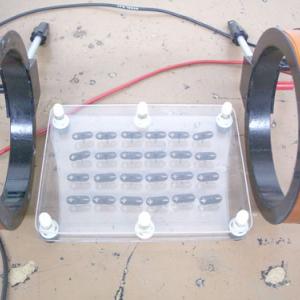College of Liberal Arts & Sciences
5G20.30 - Overhead Magnetic Domain Model
Place the apparatus on the overhead projector. Bring a bar magnetic up to the side or top of the apparatus and note how all of the small magnets line up.
NOTE: Do not touch the bar magnet to the top Plexiglas plate. This will actually re-magnetize the small magnets inside the unit.
The two models have different crystal structure. One is a cubic model and the other is a hexagonal model.
You may also show the domain change by arranging the two coils at the end of the domain model. Apply current and watch the domain line up. Reverse the current and watch the domain reverse its direction.
NOTE: The coils shown are from the Tel Atomic e/m tube demonstration.
- Hector G. Riveros, Julian Betancourt, "Interacting Compasses", TPT, Vol. 47, # 7, Oct. 2009, p. 460.
- David G. Haase, "About Magnetized Needles and Magnetic Field Lines", TPT, Vol. 27, # 5, May 1989, p. 387.
- Es-1, 2: Freier and Anderson, A Demonstration Handbook for Physics.
- Jearl Walker, "5.39, Earth's Magnetic Field and Archaeology", The Flying Circus of Physics Ed. 2, p. 236.
- "350, The Bathtub Vortex", Christopher P. Jargodzki and Franklin Potter, Mad About Physics, p. 137, 276.
- Janice VanCleave, "Magnetic Shake-Up", Physics for Every Kid - 101 Easy Experiments in Motion, Heat, Light, Machines, and Sound, p. 46 - 47.
- Janice VanCleave, "16, Permanent", Magnets, p. 64.
- Ron Hipschman, "Magnetic Lines of Force", Exploratorium Cookbook II, p. 92.1 - 92.2.
- Simon Quellen Field, "More About Magnets", Gonzo Gizmo's, p. 11 - 14.
- Rudolf F. Graf, "Proving the Theory of Magnetism", Safe and Simple Electrical Experiments, p. 53.
Disclaimer: These demonstrations are provided only for illustrative use by persons affiliated with The University of Iowa and only under the direction of a trained instructor or physicist. The University of Iowa is not responsible for demonstrations performed by those using their own equipment or who choose to use this reference material for their own purpose. The demonstrations included here are within the public domain and can be found in materials contained in libraries, bookstores, and through electronic sources. Performing all or any portion of any of these demonstrations, with or without revisions not depicted here entails inherent risks. These risks include, without limitation, bodily injury (and possibly death), including risks to health that may be temporary or permanent and that may exacerbate a pre-existing medical condition; and property loss or damage. Anyone performing any part of these demonstrations, even with revisions, knowingly and voluntarily assumes all risks associated with them.




